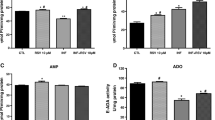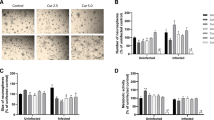Abstract
The intracellular protozoan Toxoplasma gondii may cause congenital toxoplasmosis and serious brain damage in fetus. However, the underlying mechanism of neuropathogenesis in brain toxoplasmosis remains unclear. For this study, neural progenitor cells (NPCs) were obtained from embryo telencephalons (embryonic day 13) and induced to proliferation in the presence of growth factors (GFs). For gathering insights into the biological effects of resveratrol (RSV) on neurogenesis, this study aimed to investigate effects of RSV concentrations (0.1 to 100 μM) on proliferation, migration and differentiation of NPCs infected by T. gondii. T. gondii infection increased the presence of cells in Sub G1 phase, reducing the global frequency of undifferentiated cells in S and G2/M phases of cell cycle and reduced cell viability/mithochondrial activity of infected NPCs. Moreover T. gondii stimulated neural migration and gliogenesis during neutral differentation. However, the treatment with RSV stimulated cell proliferation, restored cellular viability of infected NPCs and exerted an inhibitory effect on gliogenesis of infected NPCs favorecing neuronal maturation during toxoplasmosis infection. Thus, we have successfully to demonstrated that RSV is promising as therapeutic for congenital toxoplasmosis.






Similar content being viewed by others
References
Dubey JP, Lago EG, Gennari SM et al (2012) Toxoplasmosis in humans and animals in Brazil: High prevalence, high burden of disease, and epidemiology. Parasitology 139:1375–1424
Vauloup-Fellous C, Bouthry E (2015) Diagnosis of maternofetal infections. Presse Med 44:621–630. https://doi.org/10.1016/j.lpm.2015.04.016
Vargas-Villavicencio JA, Besné-Mérida A, Correa D (2016) Vertical transmission and fetal damage in animal models of congenital toxoplasmosis: A systematic review. Vet Parasitol 223:195–204
Elsheikha HM (2008) Congenital toxoplasmosis: Priorities for further health promotion action. Public Health 122:335–353. https://doi.org/10.1016/j.puhe.2007.08.009
Hampton MMM (2015) Congenital Toxoplasmosis: A Review. Neonatal Network:NN; New York 34:274–278
McAuley JB (2014) Congenital toxoplasmosis. J Pediatric Infect Dis Soc 3:30–35. https://doi.org/10.1093/jpids/piu077
Wang T, Zhou J, Gan X et al (2014) Toxoplasma gondii induce apoptosis of neural stem cells via endoplasmic reticulum stress pathway. Parasitology 141:988–995. https://doi.org/10.1017/S0031182014000183
Mendez OA, Koshy AA (2017) Toxoplasma gondii: Entry, association, and physiological influence on the central nervous system. PLoS Pathog 13:e1006351
Koshy AA, Dietrich HK, Christian DA, Melehani JH, Shastri AJ, Hunter CA, Boothroyd JC (2012) Toxoplasma co-opts host cells it does not invade. PLoS Pathog 8(18):e1002825. https://doi.org/10.1371/journal.ppat.1002825
Pangeni R, Sahni JK, Ali J, Sharma S, Baboota S (2014) Resveratrol: Review on therapeutic potential and recent advances in drug delivery. Expert Opin Drug Deliv 11:1285–1298. https://doi.org/10.1517/17425247.2014.919253
Gülçin I (2010) Antioxidant properties of resveratrol: A structure-activity insight. Innov Food Sci Emerg Technol 11:210–218. https://doi.org/10.1016/j.ifset.2009.07.002
Bastianetto S, Ménard C, Quirion R (2015) Neuroprotective action of resveratrol. Biochim Biophys Acta - Mol Basis Dis 1852:1195–1201
Sun AY, Wang Q, Simonyi A, Sun GY (2010) Resveratrol as a therapeutic agent for neurodegenerative diseases. Mol Neurobiol 41:375–383
Pasinetti GM a, Wang J, Ho L et al (2015) Roles of resveratrol and other grape-derived polyphenols in Alzheimer’s disease prevention and treatment. Biochim Biophys Acta 1852:1202–1208. https://doi.org/10.1016/j.bbadis.2014.10.006
Bottari NB, Baldissera MD, Tonin AA, Rech VC, Nishihira VSK, Thomé GR, Schetinger MRC, Morsch VM et al (2015) Sulfamethoxazole-trimethoprim associated with resveratrol for the treatment of toxoplasmosis in mice: Influence on the activity of enzymes involved in brain neurotransmission. Microb Pathog 79:17–23. https://doi.org/10.1016/j.micpath.2015.01.001
Kumar V, Pandey A, Jahan S, Shukla RK, Kumar D, Srivastava A, Singh S, Rajpurohit CS et al (2016) Differential responses of trans-resveratrol on proliferation of neural progenitor cells and aged rat hippocampal neurogenesis. Sci Rep 6. https://doi.org/10.1038/srep28142
Hutton SR, Pevny LH (2008) Isolation, culture, and differentiation of progenitor cells from the central nervous system. Cold Spring Harb Protoc 3:1–5. https://doi.org/10.1101/pdb.prot5077
William-Faltaos S, Rouillard D, Lechat P, Bastian G (2006) Cell cycle arrest and apoptosis induced by oxaliplatin (L-OHP) on four human cancer cell lines. Anticancer Res 26:2093–2099
William-Faltaos S, Rouillard D, Lechat P, Bastian G (2006) Cell cycle arrest and apoptosis induced by oxaliplatin (L-OHP) on four human cancer cell lines. Anticancer Res 26:2093–2099
Trujillo CA, Negraes PD, Schwindt TT, Lameu C, Carromeu C, Muotri AR, Pesquero JB, Cerqueira DM et al (2012) Kinin-B2 receptor activity determines the differentiation fate of neural stem cells. J Biol Chem 287:44046–44061. https://doi.org/10.1074/jbc.M112.407197
Pillat MM, Cheffer A, de Andrade CM, Morsch VM, Schetinger MRC, Ulrich H (2015) Bradykinin-induced inhibition of proliferation rate during neurosphere differentiation: Consequence or cause of neuronal enrichment? Cytom Part A 87:929–935. https://doi.org/10.1002/cyto.a.22705
Negraes PD, Schwindt TT, Trujillo CA, Ulrich H (2012) Neural differentiation of P19 carcinoma cells and primary neurospheres: Cell morphology, proliferation, viability. and functionality Curr Protoc Stem Cell Biol 1. https://doi.org/10.1002/9780470151808.sc02d09s20
McLaren FH, Svendsen CN, Van der Meide P, Joly E (2001) Analysis of neural stem cells by flow cytometry: Cellular differentiation modifies patterns of MHC expression. J Neuroimmunol 112:35–46. https://doi.org/10.1016/j.brainresbull.2008.08.019
Sambrook J, Fritsch EF, Maniatis T (1989) Molecular cloning: A laboratory manual. Cold Spring Harbor laboratory press
Yai LEO (2000) Avaliação da infecção experimental por Toxoplasma gondii em suínos pelas provas de bioensaio em camundongos e reação em cadeia de polimerase. Dissertação (Mestrado em Epidemiologia e Aplicação as Zoonoses). Faculdade de Med. Veterinaria e Zootecnia.
Wang T, Liu M, Gao XJ, Zhao ZJ, Chen XG, Lun ZR (2011) Toxoplasma gondii: The effects of infection at different stages of pregnancy on the offspring of mice. Exp Parasitol 127:107–112. https://doi.org/10.1016/j.exppara.2010.07.003
Dubey JP (2009) Toxoplasmosis of animals and humans. Lancet 363:1965–1976. https://doi.org/10.1017/S0031182000078914
Contreras-Ochoa CO, Lagunas-Martínez A, Belkind-Gerson J, Díaz-Chávez J, Correa D (2013) Toxoplasma gondii invasion and replication within neonate mouse astrocytes and changes in apoptosis related molecules. Exp Parasitol 134:256–265. https://doi.org/10.1016/j.exppara.2013.03.010
Mordue DG, Monroy F, La Regina M et al (2001) Acute toxoplasmosis leads to lethal overproduction of Th1 cytokines. J Immunol 167:4574–4584. https://doi.org/10.4049/jimmunol.167.8.4574
Nishikawa Y, Kawase O, Vielemeyer O et al (2007) Toxoplasma gondii infection induces apoptosis in noninfected macrophages: Role of nitric oxide and other soluble factors. Parasite Immunol 29:375–385. https://doi.org/10.1111/j.1365-3024.2007.00956.x
Leong C-W, Wong CH, Lao S-C, Leong EC, Lao IF, Law PTW, Fung KP, Tsang KS et al (2007) Effect of resveratrol on proliferation and differentiation of embryonic cardiomyoblasts. Biochem Biophys Res Commun 360:173–180. https://doi.org/10.1016/j.bbrc.2007.06.025
Della Ragione F, Cucciolla V, Borriello A et al (1998) Resveratrol arrests the cell division cycle at S/G2 phase transition. Biochem Biophys Res Commun 250:53–58. https://doi.org/10.1006/bbrc.1998.9263
Sun AY, Wang Q, Simonyi A, Sun GY (2010) Resveratrol as a therapeutic agent for neurodegenerative diseases. Mol Neurobiol 41:375–383
Kim YA, Kim G-Y, Park K-Y, Choi YH (2007) Resveratrol inhibits nitric oxide and prostaglandin E 2 production by lipopolysaccharide-activated C6 microglia. J Med Food 10:218–224. https://doi.org/10.1089/jmf.2006.143
Mora-Bermúdez F, Huttner WB (2015) Novel insights into mammalian embryonic neural stem cell division: Focus on microtubules. Mol Biol Cell 26:4302–4306. https://doi.org/10.1091/mbc.E15-03-0152
Gage FH, Temple S (2013) Neural stem cells: Generating and regenerating the brain. Neuron 80:588–601
Creuzet C, Robert F, Roisin MP, van Tan H, Benes C, Dupouy-Camet J, Fagard R (1998) Neurons in primary culture are less efficiently infected by toxoplasma gondii than glial cells. Parasitol Res 84:25–30. https://doi.org/10.1007/s004360050351
Cabral CM, Tuladhar S, Dietrich HK, Nguyen E, MacDonald WR, Trivedi T, Devineni A, Koshy AA (2016) Neurons are the primary target cell for the brain-tropic intracellular parasite Toxoplasma gondii. PLoS Pathog 12:e1005447. https://doi.org/10.1371/journal.ppat.1005447
Fischer HG, Nitzgen B, Reichmann G, Groß U, Hadding U (1997) Host cells of Toxoplasma gondii encystation in infected primary culture from mouse brain. Parasitol Res 83:637–641. https://doi.org/10.1007/s004360050311
Parlog A, Schlüter D, Dunay IR (2015) Toxoplasma gondii -induced neuronal alterations. Parasite Immunol 37:159–170. https://doi.org/10.1111/pim.12157
Izant JG, McIntosh JR (1980) Microtubule-associated proteins: A monoclonal antibody to MAP2 binds to differentiated neurons. Proc Natl Acad Sci U S A 77:4741–4745. https://doi.org/10.1073/pnas.77.8.4741
Lüder CGK, Giraldo-Velásquez M, Sendtner M, Gross U (1999) Toxoplasma gondii in primary rat CNS cells: Differential contribution of neurons, astrocytes, and microglial cells for the intracerebral development and stage differentiation. Exp Parasitol 93:23–32. https://doi.org/10.1006/expr.1999.4421
Berenreiterová M, Flegr J, Kuběna AA, Němec P (2011) The distribution of Toxoplasma gondii cysts in the brain of a mouse with latent toxoplasmosis: Implications for the behavioral manipulation hypothesis. PLoS One 6:e28925. https://doi.org/10.1371/journal.pone.0028925
Funding
This work was supported by the Coordenação de Aperfeiçoamento Pessoal de Nível Superior (CAPES), and Conselho Nacional de Desenvolvimento Científico e Tecnológico (CNPq - Project N°. 304,328/2015–4), Brazil. MPP acknowledges postdoctoral fellowship support by Fundação de Amparo à Pesquisa do Estado de São Paulo (FAPESP Project N°. 2015/19478–3). H.U. acknowledges grant support from FAPESP for investigating mechanisms of neurogenesis (Project N°. 2012/50880–4).
Author information
Authors and Affiliations
Corresponding author
Ethics declarations
Conflict of Interest
The authors declare that they have no conflict of interest.
Rights and permissions
About this article
Cite this article
Bottari, N.B., Schetinger, M.R.C., Pillat, M.M. et al. Resveratrol as a Therapy to Restore Neurogliogenesis of Neural Progenitor Cells Infected by Toxoplasma gondii. Mol Neurobiol 56, 2328–2338 (2019). https://doi.org/10.1007/s12035-018-1180-z
Received:
Accepted:
Published:
Issue Date:
DOI: https://doi.org/10.1007/s12035-018-1180-z




